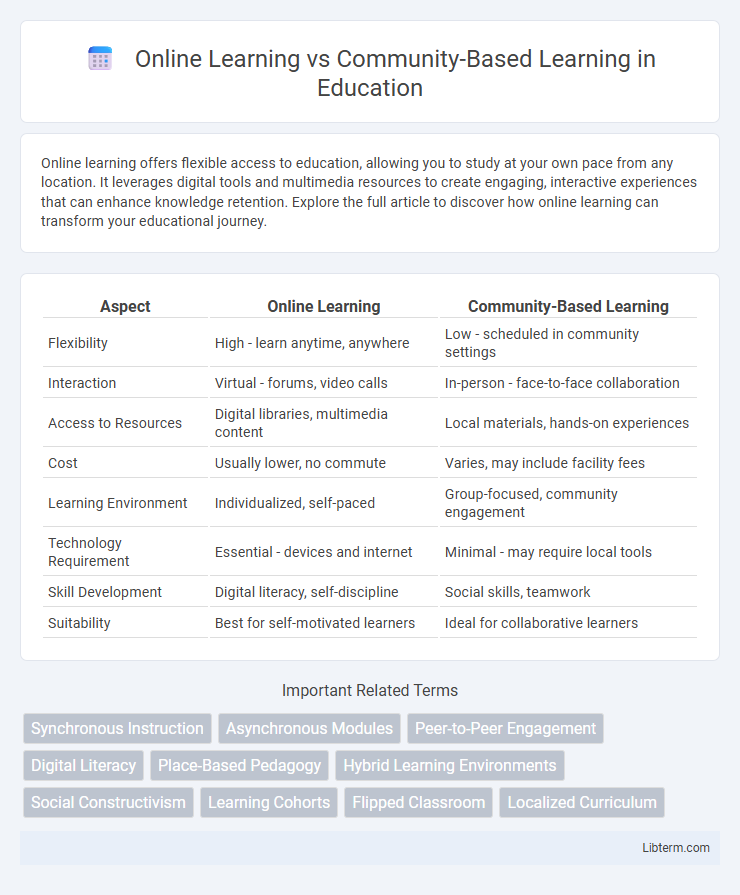Online learning offers flexible access to education, allowing you to study at your own pace from any location. It leverages digital tools and multimedia resources to create engaging, interactive experiences that can enhance knowledge retention. Explore the full article to discover how online learning can transform your educational journey.
Table of Comparison
| Aspect | Online Learning | Community-Based Learning |
|---|---|---|
| Flexibility | High - learn anytime, anywhere | Low - scheduled in community settings |
| Interaction | Virtual - forums, video calls | In-person - face-to-face collaboration |
| Access to Resources | Digital libraries, multimedia content | Local materials, hands-on experiences |
| Cost | Usually lower, no commute | Varies, may include facility fees |
| Learning Environment | Individualized, self-paced | Group-focused, community engagement |
| Technology Requirement | Essential - devices and internet | Minimal - may require local tools |
| Skill Development | Digital literacy, self-discipline | Social skills, teamwork |
| Suitability | Best for self-motivated learners | Ideal for collaborative learners |
Introduction to Online and Community-Based Learning
Online learning leverages digital platforms to provide flexible access to educational content anytime and anywhere, often featuring interactive tools and multimedia resources. Community-based learning emphasizes experiential education through direct engagement with local environments and social contexts, fostering collaboration and real-world problem-solving. Both methods aim to enhance learner outcomes by catering to diverse needs and promoting active participation.
Defining Online Learning: Key Features
Online learning is characterized by its digital platform delivery, enabling access to educational content anytime and anywhere with internet connectivity. Key features include asynchronous and synchronous course formats, multimedia resources, and interactive tools such as discussion forums and virtual classrooms. This mode supports personalized pacing, diverse instructional methods, and global learner engagement without geographical constraints.
Understanding Community-Based Learning
Community-based learning emphasizes active participation within local or virtual communities, fostering collaboration, real-world problem-solving, and social engagement that enhances experiential understanding. This educational approach integrates community resources and relationships to build practical skills and cultural awareness, supporting deeper cognitive and emotional connections. By embedding learning in authentic contexts, community-based learning produces outcomes aligned with communal values and social responsibility, distinguishing it from the often more isolated nature of online learning environments.
Accessibility and Flexibility Comparison
Online learning offers unparalleled accessibility by enabling students to access educational content anytime and anywhere with an internet connection, removing geographical and time barriers. Community-based learning provides flexibility through localized, often in-person interactions that foster social engagement and hands-on experiences tailored to community needs. While online platforms excel in individual adaptability, community-based approaches enhance contextual relevance and collective participation.
Social Interaction in Both Models
Online learning offers flexible social interaction through virtual forums and live video discussions, enabling connections across geographic boundaries but often lacking in spontaneous, face-to-face communication. Community-based learning emphasizes direct interpersonal engagement, fostering deeper collaboration, immediate feedback, and stronger social bonds within a shared physical environment. Both models support social interaction, but community-based learning typically cultivates more dynamic and tactile social experiences essential for developing communication and teamwork skills.
Learning Outcomes and Effectiveness
Online learning offers flexible access to diverse resources and personalized pacing, enhancing knowledge retention and self-discipline for many learners. Community-based learning promotes collaborative problem-solving and real-world application, fostering critical thinking and interpersonal skills through direct engagement. Studies indicate blended approaches combining online content with community interaction yield the highest learning outcomes and overall effectiveness.
Technological Requirements and Barriers
Online learning necessitates reliable internet access, compatible devices, and user-friendly platforms to facilitate seamless virtual instruction and interaction. Community-based learning often relies more on physical presence, requiring access to local resources and face-to-face engagement, which can be hampered by geographical and mobility constraints. Technological barriers in online learning include inadequate digital skills and limited infrastructure, while community-based learning faces challenges such as inconsistent resource availability and less flexibility in scheduling.
Student Engagement: Challenges and Solutions
Student engagement in online learning faces challenges such as limited real-time interaction, distractions from non-academic environments, and decreased motivation due to isolation. Community-based learning promotes active participation and social collaboration, but can struggle with inconsistent attendance and resource limitations. Solutions include integrating interactive digital tools in online courses and fostering local peer support networks within community programs to enhance engagement and accountability.
Case Studies: Success Stories and Pitfalls
Case studies reveal that online learning platforms like Coursera and Khan Academy have successfully increased accessibility and personalized education through adaptive algorithms, boosting student engagement by up to 40%. Community-based learning models, exemplified by initiatives such as the Harlem Children's Zone, demonstrate improved social outcomes and collaborative skills by leveraging local resources and peer support networks. However, pitfalls include online learning's digital divide issues and the potential for community programs to face funding instability, limiting scalability and consistent impact.
Future Trends in Educational Approaches
Future trends in educational approaches emphasize the integration of online learning platforms with community-based learning to create hybrid models that enhance accessibility and engagement. Advances in AI-driven personalized learning and immersive technologies like virtual reality will further bridge the gap between digital education and real-world community interaction. Data from EDUCAUSE reveals that 85% of institutions plan to adopt blended learning methods, highlighting a shift towards more flexible, learner-centered environments for the future.
Online Learning Infographic

 libterm.com
libterm.com